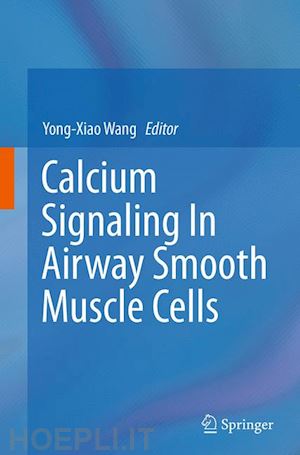
Questo prodotto usufruisce delle SPEDIZIONI GRATIS
selezionando l'opzione Corriere Veloce in fase di ordine.
Pagabile anche con Carta della cultura giovani e del merito, 18App Bonus Cultura e Carta del Docente
This book explores the role calcium signaling plays in cellular responses in almost all types of cells including airway smooth muscle cells. This universal signaling may result from extracellular calcium influx and/or intracellular calcium release, which are precisely controlled and regulated by ion channels, exchangers and/or transporters on the plasmalemmal or sarcoplasmic reticulum membrane. First, several chapters detail calcium release channels (ryanodine receptors and inositol trisphosphate receptors), voltage-dependent potassium channels, transient receptor potential channels, Orai channels, calcium-activated potassium channels, and calcium-activated chloride channels. Well-characterized sodium-calcium exchangers, voltage-dependent calcium channels, and calcium pumps are described also in depth over many chapters.
Ca2+ signaling can be expressed in Ca2+ sparks, waves, oscillations, and global changes in intracellular Ca2+ concentration. Calcium in subcellular compartments (cytosol, sarcoplasmic reticulum, mitochondria, and caveolae) also exhibit dynamic crosstalk. Many molecules including FK506 binding proteins, cyclic adenosine diphosphate ribose, reactive oxygen species, RhoA kinases, caveolin and integrins can modify and induce spatial, temporal and compartmental variations of calcium signaling. In addition, calcium signaling can exhibit sex hormone- and age-dependent changes. A number of chapters are dedicated to covering these diverse formats, spatiotemporal characteristics, multifaceted network and mathematical modeling of Ca2+ signaling.
Neurotransmitters, hormones, growth factors, inflammatory cytokines, and other stimuli may lead to multiple cellular responses by inducing Ca2+ signaling in airway smooth muscle cells. Increasing evidence suggests that Ca2+ pumps and canonical transient receptor potential channels are essential for airway smooth muscle remodeling. Accordingly, several chapters summarize recent advances in the studies of the key role of calcium signaling in physiological cellular responses as well as the development of asthma, chronic obstructive pulmonary disease and other respiratory disorders.
Ryanodine and Inositol Trisphosphate Receptors/Ca2+ Release Channels in Airway Smooth Muscle Cells.- Kv7 (KCNQ) Potassium Channels and L-type Calcium Channels in the Regulation of Airway Diameter.- Transient Receptor Potential and Orai Channels in Airway Smooth Muscle Cells.- Large-conductance calcium-activated potassium channels.- Calcium-activated Chloride Channels.- Local Calcium Signaling in Airway Smooth Muscle Cells.- Regulation of Airway Smooth Muscle Contraction by Ca2+ Signaling: Physiology Revealed by Microscopy Studies of Lung Slices.- Temporal Aspects of Ca2+ Signaling in Airway Myocytes.- Mechanisms Underlying Ca2+ Store Refilling in Airway Smooth Muscle.- Novel Mechanisms in Ca2+-homeostasis and Internal Store Refilling of Airway Smooth Muscle.- The Role of Mitochondria in Calcium Regulation in Airway Smooth Muscle.- Role of Caveolae in the Airway.- CD38 – Cyclic ADP-ribose-mediated Calcium Signaling in Airway Myocytes.- The Pathways and Signaling Cross-talk with Oxidant in Calcium Influx in Airway Smooth Muscle Cells.- Role of RhoA/Rho-kinase and Calcium Sensitivity in Airway Smooth Muscle Functions.- Role of Integrins in the Regulation of Calcium Signaling.- Sex Steroid Signaling in the Airway.- Regulation of Contractility in Immature Airway Smooth Muscle.- Mathematical Modeling of Calcium Dynamics in Airway Smooth Muscle Cells.- Effects of Inflammatory Cytokines on Ca2+ Homeostasis in Airway Smooth Muscle Cells.- Ca2+ Signaling and P2 Receptors in Airway Smooth Muscle.- Calcium Signaling in Airway Smooth Muscle Remodeling.- Regulation of Intracellular Calcium by Bitter Taste Receptors on Airway Smooth Muscle.- Modulation of Airway Smooth Muscle Contractile Function by TNFa and IL-13 and Airway Hyper-responsiveness in Asthma.- Airway Smooth Muscle Malfunction in COPD.











Il sito utilizza cookie ed altri strumenti di tracciamento che raccolgono informazioni dal dispositivo dell’utente. Oltre ai cookie tecnici ed analitici aggregati, strettamente necessari per il funzionamento di questo sito web, previo consenso dell’utente possono essere installati cookie di profilazione e marketing e cookie dei social media. Cliccando su “Accetto tutti i cookie” saranno attivate tutte le categorie di cookie. Per accettare solo deterninate categorie di cookie, cliccare invece su “Impostazioni cookie”. Chiudendo il banner o continuando a navigare saranno installati solo cookie tecnici. Per maggiori dettagli, consultare la Cookie Policy.